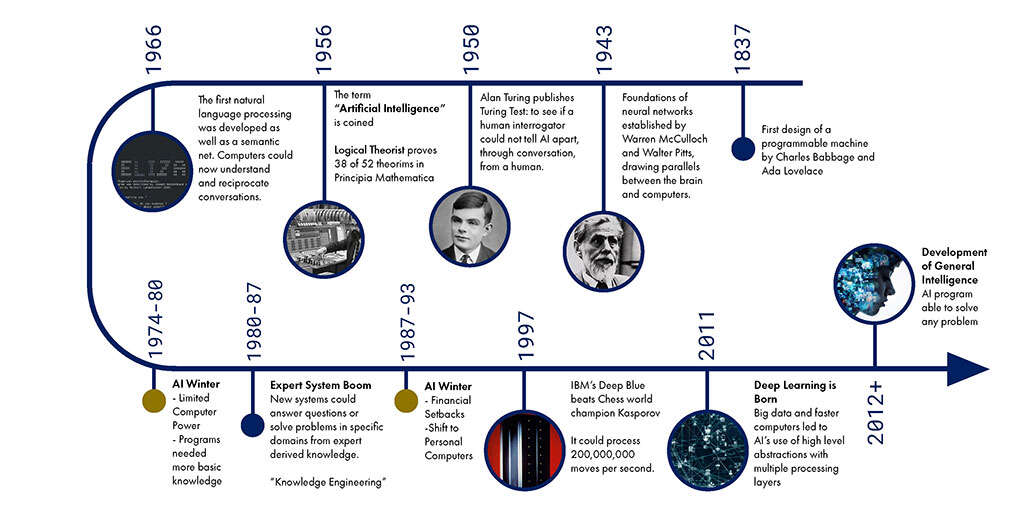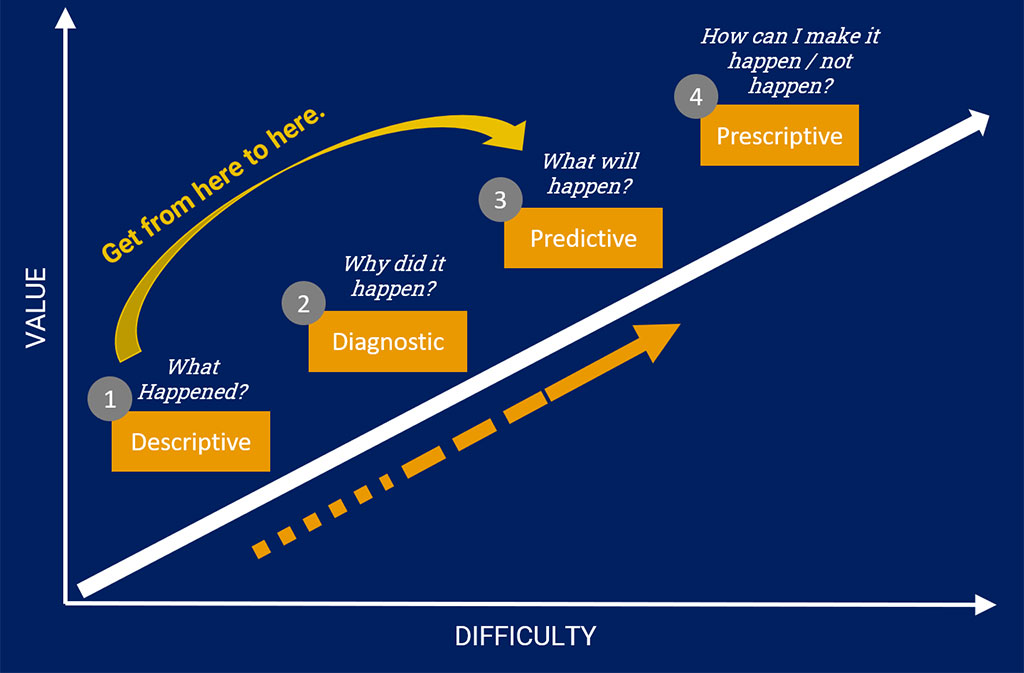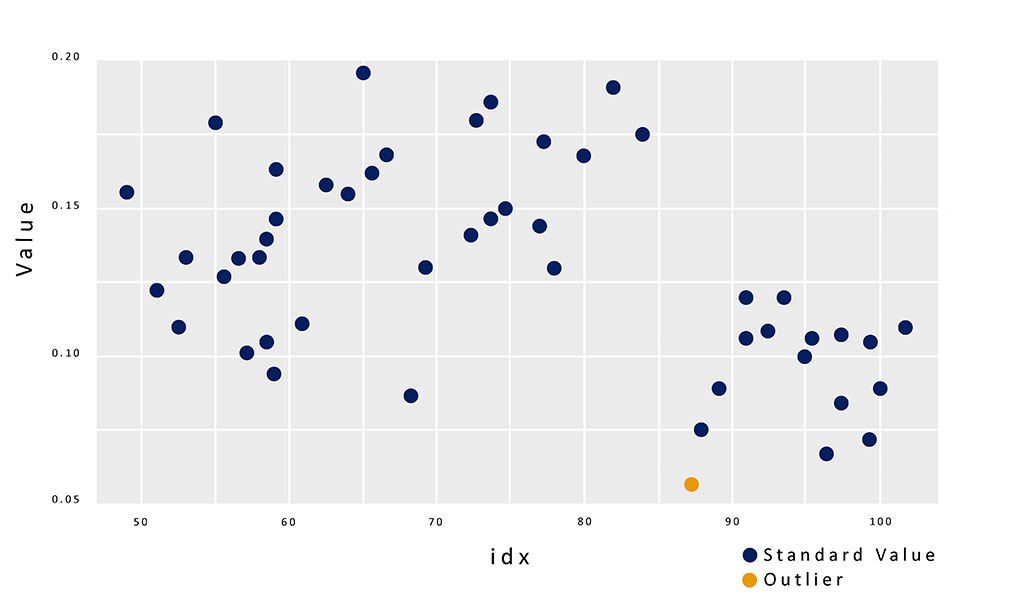The modern field of Artificial Intelligence (AI) is perhaps, not so modern but rather a journey over almost three centuries of improved workflows to create more efficient and responsive processes. AI in its current state is not a replacement for human intelligence and ingenuity but rather a support tool. Today’s AI is taking digital computing out of the 2-dimensional world of screens and dashboards to produce 3-dimensional tools that function effortlessly in our physical world.
Where are we today, and how will it impact small and medium-sized businesses tomorrow?
Human Resource Management
HR teams can use the power of data to streamline workflows and make better decisions. AI can improve hiring, candidate screening, and employee experiences by automating repetitive tasks that are of low value and freeing up time to focus on more strategic, creative work.
As it relates to recruitment and hiring, larger companies can receive thousands of applicants per month. AI enables this volume of applicants to be screened and categorized promptly without unconscious bias. Companies need to ensure that their process and algorithms are transparent to avoid any inadvertent bias, as experienced by Amazon a few years ago.
AI technologies can also streamline the evaluation and onboarding processes by scheduling interviews, introducing new hires to job duties and benefits, providing company contacts, addressing frequently asked questions, and even arranging for the assignment of work-related hardware. AI does not replace recruiters or HR Managers but can augment their capabilities so that they hire the right person for a job.
Employee management and retention can be enhanced with AI technologies. HR Managers can gather information from employees through direct responses and can also use data analytics to understand employee’s sentiments better as it relates to policies.
Over the last year, many large companies have used sentiment analysis of employee survey results and chatbot interactions to assess how they were coping with the stress of COVID-19, working remotely, and other company changes related to the pandemic.
Marketing and Communications
AI marketing uses artificial intelligence technologies to make automated decisions based on data collection, data analysis, and additional observations of audience or economic trends that may impact marketing performance.
The emergence of digital media brought a tidal wave of big data, which has allowed marketers to understand their efforts better and accurately attribute value across channels. This has also led to an over-saturation of data. Effective AI-powered solutions provide marketers with a central platform for managing the expansive amounts of data being collected.
AI is being used in marketing initiatives in many use cases across a broad array of industries, including financial services, government, entertainment, healthcare, retail, and more. Each AI technology application can offer different results, from improvements to campaign performance, enhanced customer experience, or greater efficiency in marketing operations.
For instance, a highly granular level of personalization is expected by today’s consumers. AI helps marketing teams go beyond standard demographic data to learn about consumer preferences on an individual level. This allows brands to build curated experiences based on a customer’s unique tastes- think about music playlists being automatically curated for you or Netflix recommending a feature film based on the previous viewing.
AI also allows marketing teams to use predictive analytics, which leverages an assortment of machine learning, algorithms, models, and datasets to predict future behavior. This can help marketing teams understand the types of products consumers will be looking for in the future and when they may want it, for example. Amazon uses predictive analytics to suggest products to consumers based on past purchases and behaviors, increasing conversions and customer satisfaction.
Freya Systems has significant experience developing software and data reporting solutions, with a specialty in predictive analytics and forecasting capabilities. A major transportation company recently asked us to look at their Ticket Revenue and Ridership Forecasting capabilities. The company wanted to update internal forecasting and modeling systems to provide a detailed analysis of the impact of variables on ridership and revenue figures. AI could not only help them forecast, but also visualize and find more compelling insights on zone-to-zone schedules, frequency changes, travel time changes, new stops, and market expansions, improving the customer’s experience and, hopefully, ridership.
Consumers have more choices today. They are no longer confined to whatever their local store has in stock; they can order what they want when they want. As a result, competition is fierce among retailers and service providers. The way to stay ahead is to predict the future. Predictive analytics allows for this, assisting marketers in understanding consumer behaviors and trends, predicting future shifts, and planning their campaigns accordingly.
Manufacturing
Implementing AI in manufacturing facilities is getting popular across industries. The most common applications are to improve maintenance procedures and improve quality control.1 There are, however, other applications of AI technology in manufacturing that will become more pervasive in the future, including design and pricing, to name a few.
Generative design
Generative design uses machine learning algorithms to mimic an engineer’s approach to design. Designers or engineers enter design parameters (such as materials, size, weight, strength, manufacturing methods, and cost constraints) into generative design software. The software provides all the possible outcomes that can be created with those parameters. With this method, manufacturers quickly generate thousands of design options for one product.
Price forecasting of raw material
The extreme price volatility of raw materials has always been a challenge for manufacturers. Businesses had to adapt to the unstable price of raw materials to remain competitive in the market. AI-powered software can predict materials prices more accurately so that managers and leaders can factor this into their plans.
Edge analytics
Edge analytics provides fast and decentralized insights from data sets collected from sensors on machines throughout the supply chain, workforce, and manufacturing process. These analytics have three use cases in manufacturing:
• Improving production quality and yield
• Detecting early signs of deteriorating performance and risk of failure
• Tracking worker health and safety by using wearables
Quality assurance
Assembly lines work based on parameters and algorithms that provide guidelines to produce the best possible end-products. AI systems can detect the differences from the usual outputs using machine vision technology since many defects are visible. When an end-product is lower quality than expected, AI systems trigger an alert to users so that they can react to make adjustments.
In most modern manufacturing organizations, operations run 24/7. You can imagine that an interruption in operation or a production line that is not operating at optimal performance will have a significant financial impact on the business. AI technologies that are fueling the digital transformation can demonstrate a substantial return on investment for business owners and shareholders.
Inventory Management/ Supply Chain
In a 2018 Price Waterhouse Cooper (PwC) report, Supply Chain Executives reported that of those who have already implemented artificial intelligence into their supply chains, 61 percent had a decrease in costs and 53 percent had increased revenues as a direct result of their AI investment.
Transportation and logistics, a crucial part of the supply chain, are cited in the PwC report as the fourth most impacted industry. Why transportation and logistics? Artificial intelligence collects and analyzes massive amounts of data from different data sources, giving transportation and logistics leaders insights they never had in the past. It opens up capabilities across the industry, from optimizing routes and automating trucks to predicting transit times and avoiding weather events.
At Freya Systems, we see the digital transformation in parts inventory management in the commercial and defense aviation industries focusing on several factors, including artificial intelligence.
The integration of artificial intelligence with aircraft fleet management will empower the development of predictive and preventive data models that foretell maintenance needs. Using AI-enabled machine learning, decision models can recommend which parts and where maintenance will be needed down the road, thereby putting an operator’s maintenance department in greater control of the workflow process. Taking a fleet management perspective also gives you greater insight into the fleet’s overall health as projected into the future.
IoT, or the network of physical objects embedded with sensors that connect to a network to relay data, will play a significant role in integrating inventory management data by expanding on today’s radio frequency capabilities. As more data is extracted from intelligent aircraft that can quickly relay real-time diagnostic data to the ground, the power and accuracy of existing fleet management software will increase and enable automatic ordering and dispatch of parts where and when they are needed. In addition, IoT will allow the proper categorization and upkeep of on-the-shelf inventories, such as engines that need to be rotated for fluid distribution, batteries that need to be charged, or fire extinguishers that have a shelf life.
Blockchain technologies will also play a vital role in managing part custody and the immutable recording of maintenance activity. This will result in improved data quality that will allow for a broader scope of insight into reliability. It will also certify, redefine, and improve maintenance activities, part-life management, and product improvement activities throughout aviation.
The future of supply chain and logistics of parts inventory management is all about enabling more intricate data collection, integrating that into intelligent data systems, and using advanced analysis to empower fleet managers with tools that reduce cost and improve workflows. These innovations aim to optimize further the aircraft maintenance supply chain: having the right part, at the right place, at the right time.
Customer Service
The distributed contact center model thrust upon us by the pandemic is an example of the new normal. Agents are and will continue to return to contact centers, but they are not all coming back. Some organizations have already decided to keep contact centers remote indefinitely, and others will operate in a hybrid capacity due to employee preferences, cost, ROI, and more. By implementing new technology and processes, such as conversation and behavioral insights, organizations can consider the “outside-in” perspective of customers, agents, and supervisors and empower data-supported awareness, action, and business improvement.
A key theme that runs through the Forrester Research report, 2021 Megatrend in Customer Service, is the idea that when organizations have a deep understanding and insights into customer conversations, they can respond. “Speech and text analytics will monitor and score customer interactions. Quality scores will drive just-in-time coaching on specific subjects to the agent desktop — as well as supervisor intervention for guidance.”
Techniques ranging from traditional machine learning to deep learning have improved speech-to-text transcription accuracy, making it easier to extract intent, topics, entities, and relationships; and measure speakers’ tone, sentiment, and emotion. Once mainly used to ensure conformity in contact centers, AI-fueled speech analytics now drives engaging customer conversations using natural language processing.
Natural language processing (NLP) is already integrated into many customer service organizations. A typical example is a chatbot. Some of the most common uses of chatbots include answering FAQs, providing out-of-hours customer support, gathering customer information, and diagnosing problems that are call-routed to the appropriate department.
Practical applications of natural language processing like this demonstrate how AI and machine learning can improve the overall customer experience. Businesses can offer immediate responses to the most commonly asked questions or problems. This creates the impression of a 24/7 customer service organization.
Our team has had experience applying sentiment analysis to speech in a past project whose application was to identify inappropriate, overly offensive, or hateful speech for online message communities. Using large data sets, we needed to identify and develop a system to determine whether words were hateful and do so for a varied set of languages. We distinguished speech by using annotated data models, marked by content experts. The model was trained for open-source applications. Code was written to ingest arbitrary collections of comments in multiple languages, and then tell you what probability those comments had of being referred to as hate speech. This inference algorithm was backed up by those annotated data sets which were tokenized and cleaned for improved effectiveness. The team utilized open-source BERT and ROBERTA models in Python for this process.
For some business leaders, it is helpful to look at AI through the lens of business capabilities rather than technologies. Broadly speaking, AI can support three important business needs:
• Automating business processes
• Gaining insight through data analysis
• Engaging with customers and employees
Robotic Processing Automation (RPA) may have the most common application in today’s business environments. RPA is being used to transfer data from emails and calls to update customer files in instances like an address change, an upgrade of service, replacing a debit/ credit card. At NASA, cost pressures led the agency to launch four RPA pilots in accounts payable and receivable, IT spending, and human resources—all managed by a shared services center. The four projects worked well—in the HR application, for example, 86% of transactions were completed without human intervention—and are being rolled out across the organization.
One might imagine that robotic process automation would quickly put people out of work. But across the 71 RPA projects studied by Harvard Business Review in 2019, replacing administrative employees was neither the primary objective nor a common outcome. Only a few projects led to reductions in headcount, and in most cases, the tasks in question had already been shifted to outsourced workers.
To Conclude
Gaining insights through data analysis has historically been done by business and financial analysts. However, the level of cognitive insight powered by machine learning is akin to giving the human brain superpowers.
Versions of machine learning (deep learning, particularly, which attempts to mimic the human brain’s activity to recognize patterns) can perform feats such as recognizing images and speech. Machine learning can also make available new data for better analytics. While data curation activity has historically been quite labor-intensive, now machine learning can identify probabilistic matches—data that is likely to be associated with the same person or company, but that appears in slightly different formats—across databases. GE began using AI-powered deep learning in 2017 to integrate supplier data and saved $80 million in its first year by eliminating redundancies and negotiating contracts previously managed at the business unit level.
Cognitive insight applications are typically used to improve performance on jobs only machines can do, like programmatic ad buying that involve such high-speed data crunching that is beyond human ability—so they’re not generally a threat to human jobs. They provide broader and deeper insights that permit business leaders to make better decisions.
Projects that engage employees and customers using natural language processing chatbots, intelligent agents, and machine learning have been more slowly adopted. Even five years ago, Facebook found that 70% of chatbot interaction requires human intervention at some point. Advances in NLP have enabled chatbot and intelligent agent integrations to grow in adoption. In most of the projects studied, the goal was not to reduce headcount but to handle increasing employee and customer interactions without adding staff. Some organizations plan to hand over routine communications to machines while transitioning customer-support personnel to more complex activities such as handling customer issues that escalate, conducting extended unstructured dialogues, or reaching out to customers before they call in with problems.
Of critical importance to the success of any AI, technology integration is having a succinct and deliverable data strategy. Data is the new oil. Having the right data expertise is what enables these technologies to run smoothly and provide value-added decision support.
*1.Capgemini Research Institute, 2019, Scaling AI in Manufacturing Operations.






